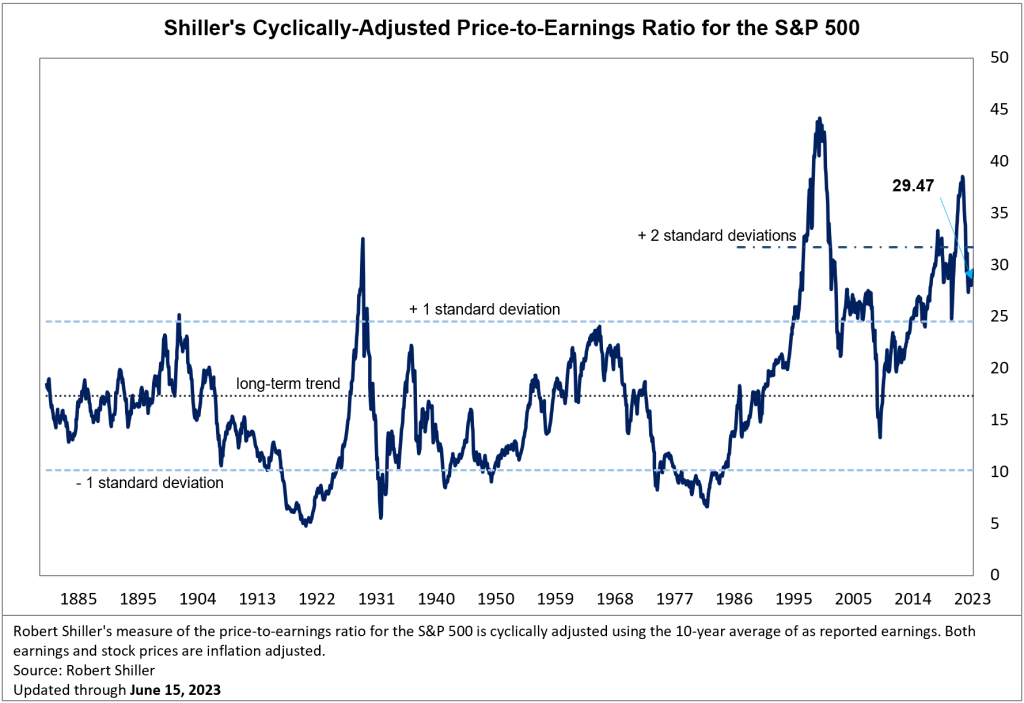June 23, 2023 | The Bear Market is Still with Us

The bear market that started in early 2022 is still intact. Many pundits are making noise about a new bull market, but it is best to ignore those people. The stock market has not completed its full correction yet.
What indicators confirm the bear market?
A normal bear market lasts until valuations are reasonable again, after an excessive overvaluation during the final stages of a bull market in stocks.
Most serious bear markets come with a recession, like 2000, 2008 and 1982. We believe that this is a serious bear market, although it has been mild so far.
The advent of a recession is always greeted by claims that the recession will have a soft landing. But there are very few instances of soft landings.
If a bear market leads to a recession, there are usually other related events such as a credit cycle. A credit cycle is a euphemistic term for the situation where many businesses go through receivership or bankruptcy to cancel debts that they are unable to repay. This credit cycle is a necessary event, like a reset, that allows the expansion of credit to resume without the baggage of the excessive borrowing and risk taking that occurred during the previous cycle.
Stock market valuation is a great indicator because it is easier to calculate than other indicators that signal the end of a bear market.
Robert Shiller, Nobel Laureate, and Professor of Economics at Yale University was awarded the Nobel for his work showing that bubbles do happen, and they do eventually burst. He updates a website that tracks the stock market in the U.S. and shows what stage of the market valuation cycle exists.


Source: Robert Shiller, Yale University
His book, Irrational Exuberance, was first published in 2000 and was inspired by the excessive valuations that were found during the dot-com bubble.
The Shiller ratio, known as the Cyclically Adjust Price Earnings Ratio for the S&P 500, reached a peak in 1999 with a ratio of stock prices to earnings of about 45, even higher than 1929. This high water mark in the ratio led to a bear market that lasted two years and took more than 50 percent off the S&P 500.
The chart shows that recent valuations are not far from the frothy heights reached in late 1999. A bear market would never end with valuations at such high levels.
The long-term average of the ratio is about 16 and the current level is over 29 or almost double the average. This alone should be a sufficient warning that the bear market is not over.
The probability of recession is high, as interest rate increases have not yet worked their way through the economy. Also, the inverted yield curve is a very reliable indicator of an imminent recession.
Bear markets usually bottom out only after a recession starts.
Investors should turn bullish only when valuations are cheap, with the CAPE below 16, and the economy is at least part way through a recession.
Hilliard MacBeth
The opinions expressed in this report are the opinions of the author and readers should not assume they reflect the opinions or recommendations of Richardson Wealth or its affiliates. Assumptions, opinions and estimates constitute the author’s judgment as of the date of this material and are subject to change without notice. We do not warrant the completeness or accuracy of this material, and it should not be relied upon as such. Before acting on any recommendation, you should consider whether it is suitable for your particular circumstances and, if necessary, seek professional advice. Past performance is not indicative of future results. The comments contained herein are general in nature and are not intended to be, nor should be construed to be, legal or tax advice to any particular individual. Accordingly, individuals should consult their own legal or tax advisors for advice with respect to the tax consequences to them, having regard to their own particular circumstances.. Richardson Wealth is a member of Canadian Investor Protection Fund. Richardson Wealth is a trademark by its respective owners used under license by Richardson Wealth.
STAY INFORMED! Receive our Weekly Recap of thought provoking articles, podcasts, and radio delivered to your inbox for FREE! Sign up here for the HoweStreet.com Weekly Recap.
Hilliard MacBeth June 23rd, 2023
Posted In: Hilliard's Weekend Notebook











